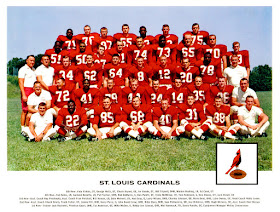Reading through some of the excellent football books of the
The prevailing theory was that most teams were "right-handed" and usually had the tight end on the right side of the offensive formation and therefore was able to help with right tackle block a particularly nasty defensive end. As such, the left defensive end needed more heft and strength than his counterpart on the other end of the line.
It was not a set-in-stone thing, for various reasons it didn't work out like that. The Steelers Steel Curtain had 6-6, 245, LC Greenwood on the left and 6-4, 260, Dwight White on the right. But usually it broke down in that fashion with Ed Jones (left) and Harvey Martin (right) and Claude Humphrey (left) and John Zook (right) and Youngblood (left) and Fred Dryer (right).
As with the Greenwood/White exception, there were others, but one is still puzzling. The 1976 Kansas City Chiefs had one disparity between right and left for the ages.
First a short background. In 1974 the Chiefs traded Curly Culp to the Houston Oilers for John Matuszak. The
In a preseason game against the Rams in Kansas City, rookie Ram lineman Dennis Harrah said to fellow rookie lineman Doug France, "Look at number 99s shoes, he must have a million cleats on them", referring to the turf shoes worn by players in that era. France would have to face Young in that game as the Rams were grooming France to replace 15-year vet Charlie Cowan.
So, in 1975 with a 280-pound left end and a 300-pound right end the Chiefs had a good outside pass rush with Young totalling 12-½ sacks and Matuszak 5-½. So, that takes the story to 1976. Matuszak goes to Washington for a stint, but ends the season with the Super Bowl Champion Oakland Raiders. His replacement was 6-2, 220-pundWhitney Paul
So, in 1975 with a 280-pound left end and a 300-pound right end the Chiefs had a good outside pass rush with Young totalling 12-½ sacks and Matuszak 5-½. So, that takes the story to 1976. Matuszak goes to Washington for a stint, but ends the season with the Super Bowl Champion Oakland Raiders. His replacement was 6-2, 220-pund
Of course, always know that the listed weights were not always accurate, especially for linemen. Paul, but by the time he took over the left end position he was around 230-pounds. Young, listed at 285, was around 300, though. Still, 230 pounds was still small, even by 1970s standards.
Perhaps Head Coach Paul Wiggin didn't want to move Young since he had a very productive 1975 season. Maybe each player preferred the side they were assigned. But it sure looked odd when you had the supposed rush end being bigger than most tackles he faces and the closed end being smaller than most linebackers in the NFL.
Whatever the reason, the production fell off, in 1976 Paul totaled 3-½ sacks and Young 1-½. The following year Paul had 3-½ and Young had 5-½. In 1978 the Chiefsspent the overall pick on Art Still to play the left end for their new 3-4 defense. Then, in 1979 they spent the
Whatever the reason, the production fell off, in 1976 Paul totaled 3-½ sacks and Young 1-½. The following year Paul had 3-½ and Young had 5-½. In 1978 the Chiefs



















